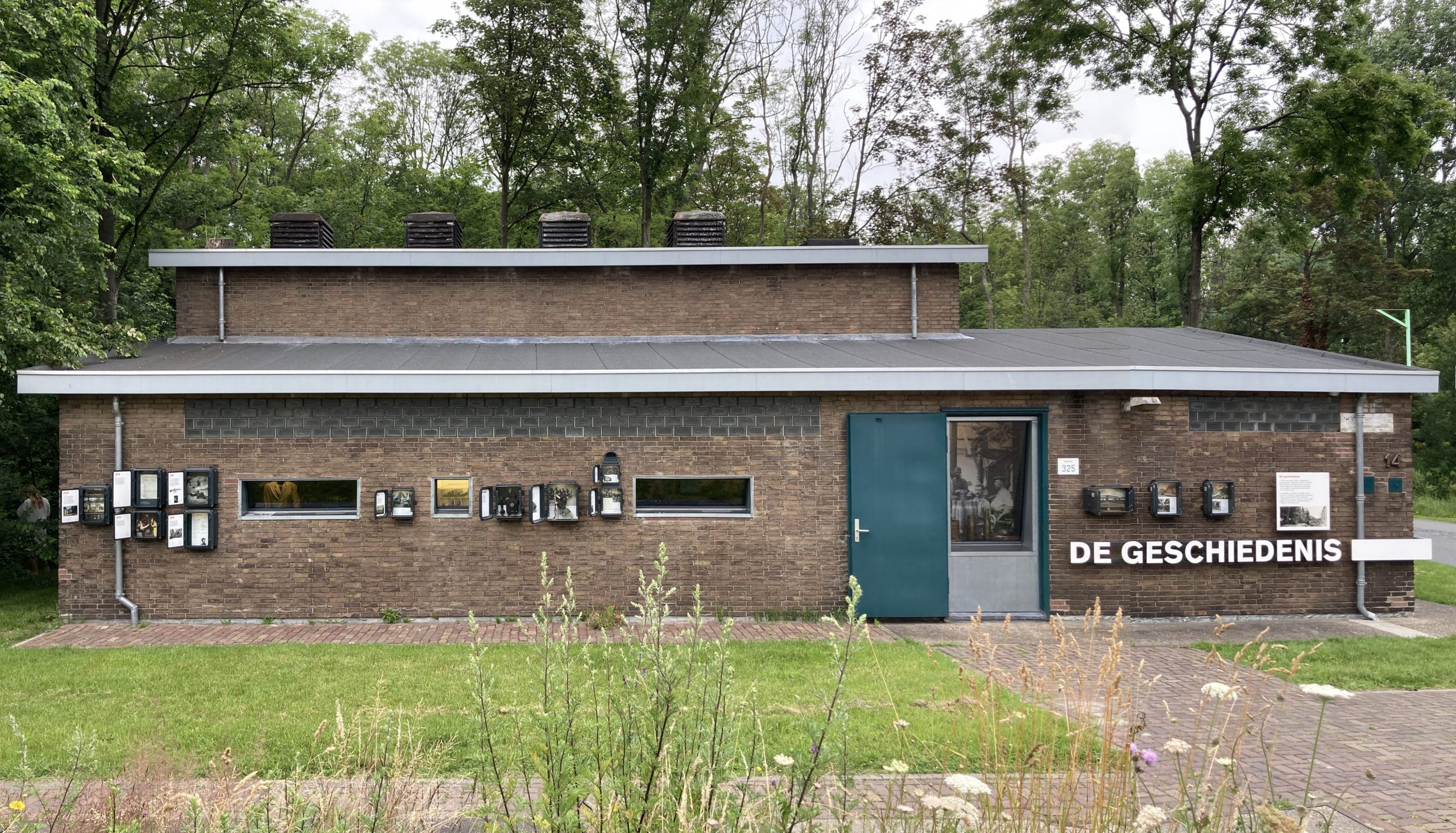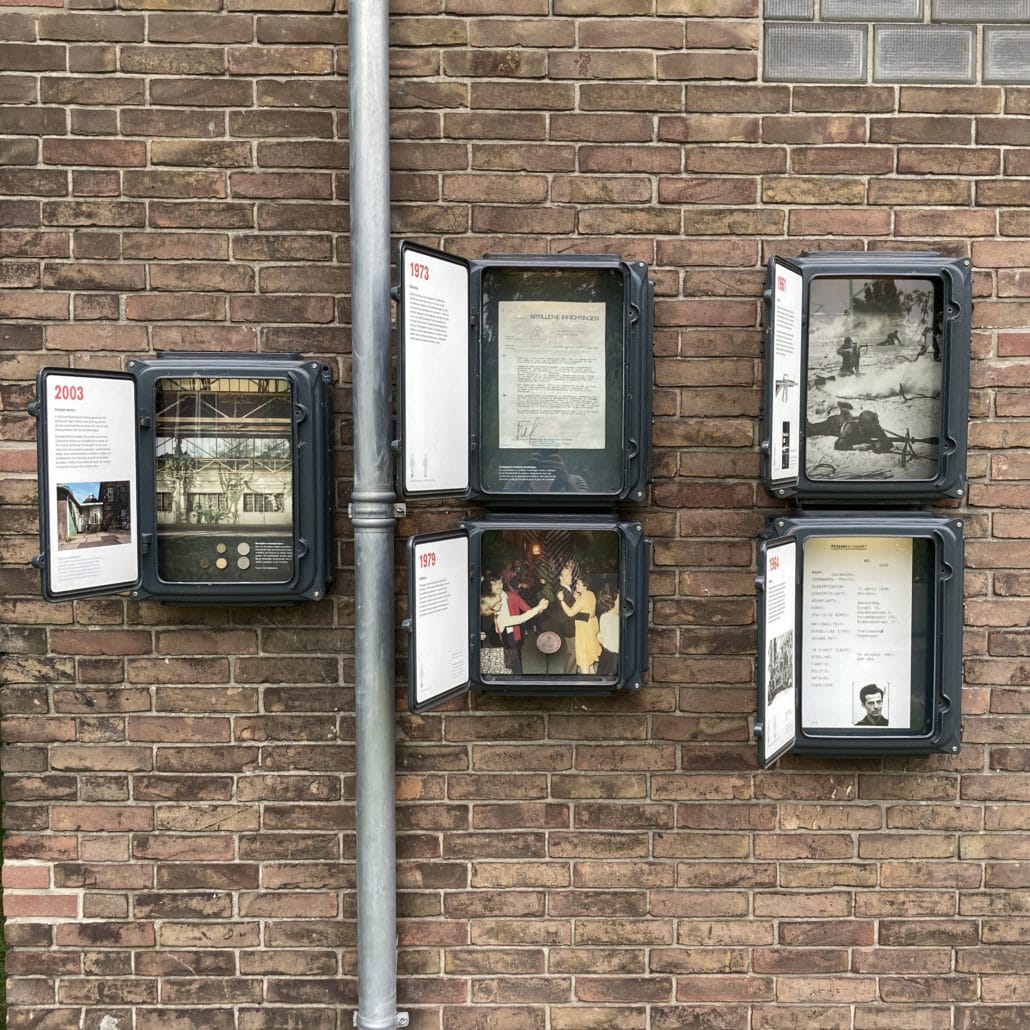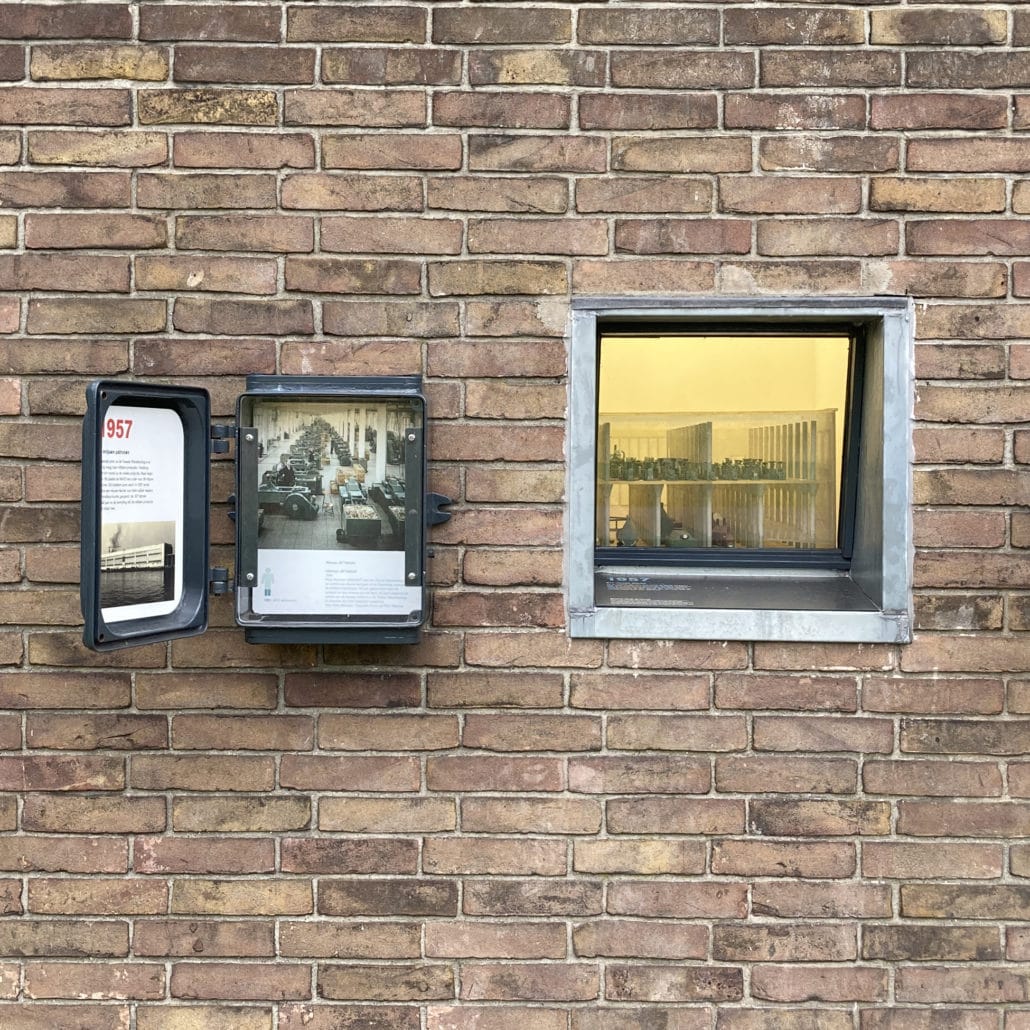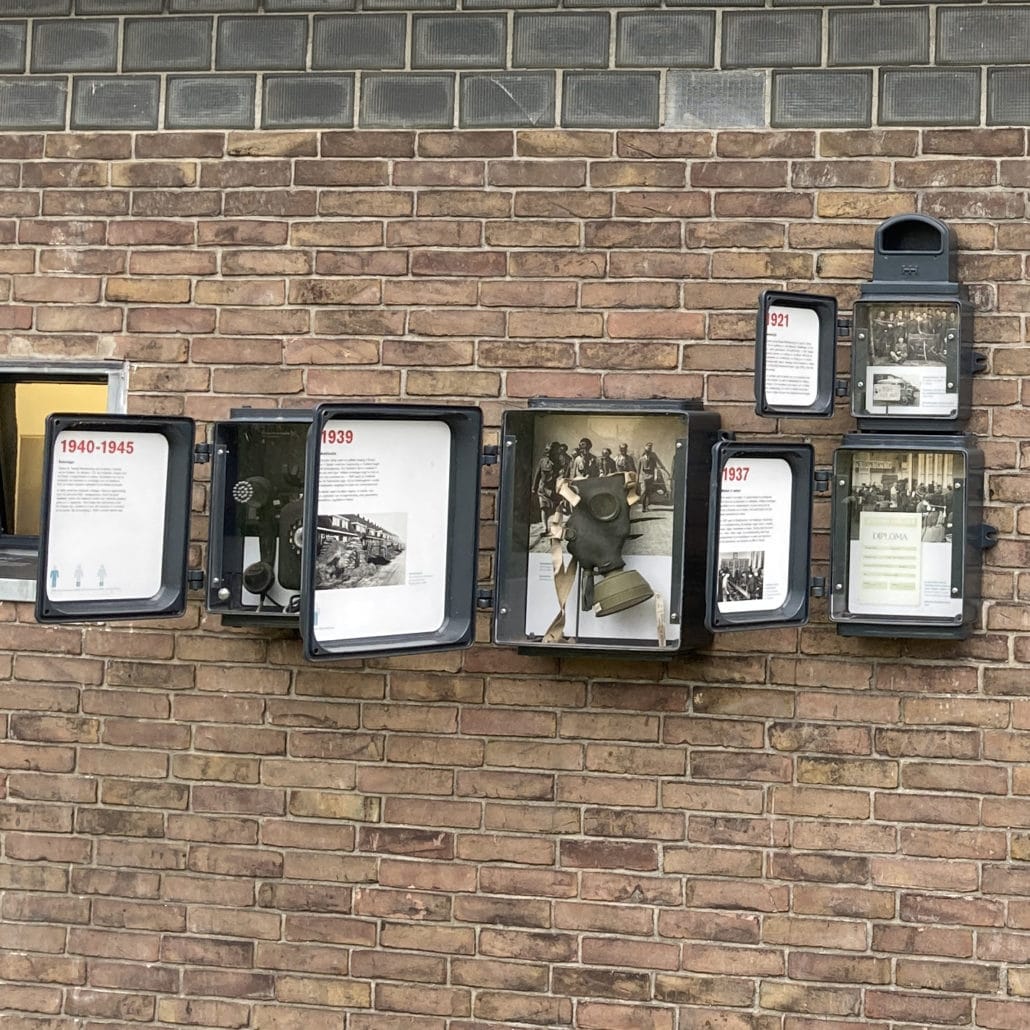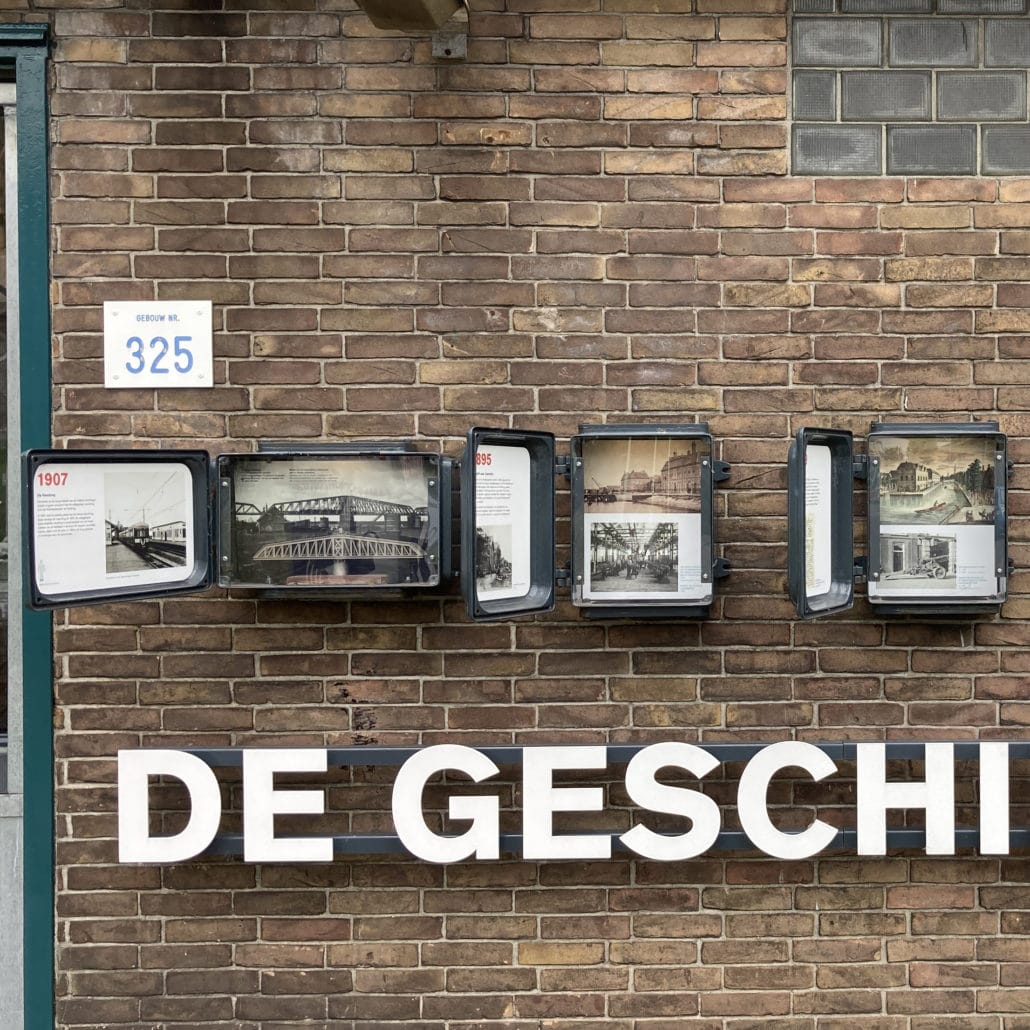Scroll down or click on a number in the image and read the English translation. Click on the arrow at the bottom right of the screen to go back up to the overview photo.
-1-
-1- 2003 Deserted site
In 1983 Machinefabriek Hembrug is bought by crane business Figee in Haarlem, where it successfully continues producing ultra-precise machines under the name Hembrug Machine Tools, which still exists to this day.
Eurometaal, however, is struggling. After the end of the Cold War, the arms factory’s future looks bleak. In order to survive, the company also looks to the civilian market. It produces solar panels, cow-milking machines, airbags, locks, advertising light boxes, central heating boilers, and blanks for the Dutch currency. This civilian production is not enough to save the company. Eurometaal finally closes down in 2003. Its inventory is auctioned off. The site is left desolate.
– Buildings on the Hembrug site
In 2012 the old factory site is repurposed as a hub for creative and innovative entrepreneurs. For the first time in over a century, the site is opened up to the public. In 2018 the Central Government Real Estate Agency sells the land to ABC Planontwikkeling BV, which will be further developing Hembrug while retaining its industrial character.
– Coin blanks
One of Eurometaal’s last civilian products. In the late 1990s, the company receives an order to make the blanks for the euro. It ‘practised’ first on the guilder. The coin blanks are punched from metal plates. The Royal Dutch Mint mints the coins from the blanks.
-2- 1979 Anniversary
Eurometaal enjoys substantial growth in the mid-1970s. 1979 is the year of the company’s 300th anniversary. Celebrations are in order, with expensive gifts and a big party for staff. Despite falling profits, the future looks bright. The 1970s are seen as boom years. This is borne out by the many extras that staff receive: little gifts at Christmas and a thirteenth month as a fixed salary component.
– Anniversary party, 1979
Utrecht’s Jaarbeurs building
– Bronze commemorative coin
To mark the anniversary, every employee of Eurometaal is given a commemorative coin and a 1 kg silver bar.
1978: approx. 1,400 people
-3- 1973 Division
Artillerie Inrichtingen has to restructure. There simply isn’t enough demand for ammunition in the Netherlands. The army is procuring more and more equipment from abroad. Civilian production cannot make up for these setbacks. In 1973, the company is split into two independent operations, a military and a civilian company: Eurometaal NV (a cooperative venture with German firm Dynamit Nobel) and Gereedschapwerktuigenindustrie Hembrug (‘Machinefabriek Hembrug’). Eurometaal opens a department in Liebenau in Germany, to fill large calibre ammunition. The hope is that international collaboration and specialization will boost production and sales.
1972: 1,150 employees
1974: approx. 700 employees
– Artillerie Inrichtingen letter of dismissal
The employees of Artillerie Inrichtingen are dismissed from the state-owned firm and recruited by one of the two newly-formed companies. Some of the staff are made redundant or retire.
-4- 1961 Loss
A tough year for Artillerie Inrichtingen. At the end of the 1950s, orders are cancelled because, having reassessed the situation, the army finds its needs less ammunition. To keep the factory running, Artillerie Inrichtingen decides to develop a new standard weapon for the Dutch army.
The management concludes an agreement with American company Fairchild Armalite to produce the AR-10 rifle under licence. In the end, the Ministry of Defence chooses a different weapon, which is a major blow to the company. In 1961, production ceases, incurring a huge loss. America subsequently develops the successful M-16 rifle from the prototype.
– Cross-section of AR-10 rifle
– Brochure bout the AR-10 rifle
The brochure explains how to dismantle and maintain the weapon.
1959: 2,000 employees
-5- 1964 Welcome
There are shortages on the job market in the Zaan region in the early 1960s. Artillerie Inrichtingen is also feeling the pinch. Women are recruited to make up the staffing shortfall. But this isn’t enough. The factory decides to recruit ‘guest workers’ from Italy, Spain, Portugal and, later on, mostly Turkey. They are not the first foreigners in the factory. Many Moluccans were already working there: former soldiers in the Royal Netherlands East Indies Army. Their compliance, discipline, and precision made them a good fit at the company.
– Turkish guest workers are welcomed to Hembrug in 1966
– Staff card
The first Italian guest workers of the Artillerie Inrichtingen
1963: 1,700 employees
1964: 1,350 employees
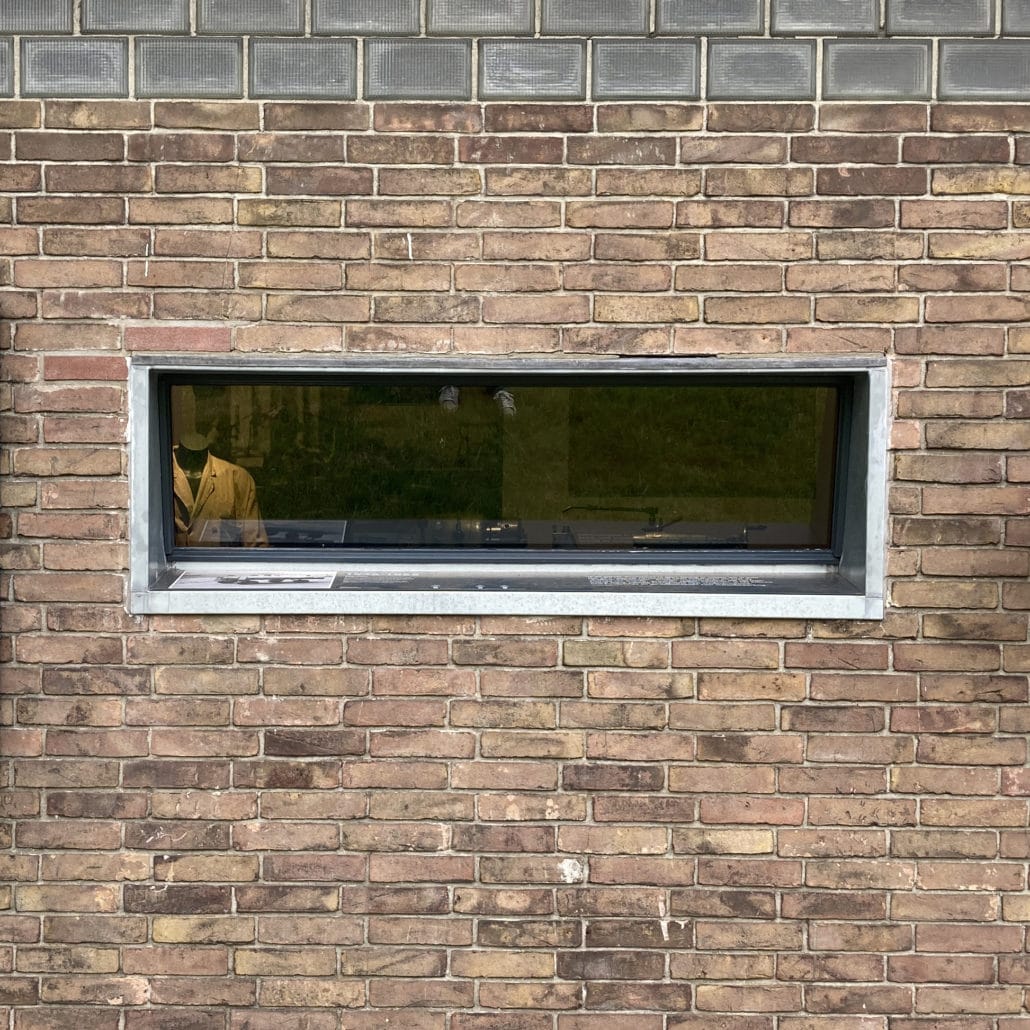
-2-
Reconstruction
In 1945, little of the factory remains. The Germans have looted the lot. With American help, production slowly grinds back into motion. The emphasis is on continuing and expanding civilian products, such as agricultural vehicles (seeders, harvesters, weeding machines and potato sorting machines), lathes, milling machines, ironing boards, drain covers, and packaging machines.
Due to the colonial war in the Dutch East Indies (1945-1949), membership of NATO (1949) and the Korean War (1950-1953), demand for munitions, weapons overhauls and military maintenance increases. The company grows once more.
– Agricultural truck
Produced by Artillerie Inrichtingen on Hembrug, circa 1950
1945: 1,600, with work for 750 people
1949: 1,200 employees
1954: 2,600 employees
Quote:
‘No other company in the Zaan region has undergone such a radical reform in the space of eight years as Artillerie-Inrichtingen. Having formerly manufactured arms to supply the army with munitions, rifles, saddles, and cannons, the huge company has now switched entirely to peacetime production: farm machinery and tools for metalworking.’
From: De Typhoon, a daily newspaper for the Zaan region, 2 October 1948
-3-
-1- 1957 36 million shells
There is little demand for military products in the first few years after the Second World War. Hembrug focuses mainly on civilian production. However, at the start of the 1950s, NATO places an order for 36 million shells. This means years of work! In 1957, a new factory is opened for small calibre weapons and machine gun ammo: the .50” factory. Twelve years after liberation, military production is back in full swing.
New .50” factory
Interior of .50” factory
1960
Peter Marcuse (1933-2017) was a professional photographer from Zaan and worked for various companies in the Zaan region, including Artillerie Inrichtingen. Fascinated by traditional crafts and people at work, he extensively documented the revival of Zaan industry after the Second World War and, in so doing, painted a unique picture of the era.
Photo: Peter Marcuse / Copyright: heirs of Peter Marcuse
1957: ca. 2000
-2- 1957 A new factory
After the Second World War, the factory is slowly but surely brought back to life, thanks chiefly to aid from the American Marshall Plan. With this support, in 1956 work commences on a new factory building for machine gun ammo, the .50” factory. The factory is opened one year later by Prince Bernhard.
– Model of the .50” factory
As well as the production of small calibre weapons and machine gun ammo (.50” cartridges), the factory also houses the central measuring chamber (CM), the chemical and metallurgical laboratory and Tool Production (Gereedschap Aanmaak, GA). Beneath the building are a number of shelters from the Cold War (1947-1991), which are later used as shooting ranges to test munitions.
-4-
-1- 1940-1945 Sabotage
During the Second World War, the factory falls into the hands of the Germans. The director, F.Q. den Hollander, refuses to work for the German war industry. He switches to producing machines and tools for agriculture. He also finds other ways to sabotage military production.
In 1943, Den Hollander is sacked. But staff continue to sabotage the Germans, including by incorrectly calibrating measuring equipment and routing trains carrying equipment to the wrong locations. In September 1944, all the employees go into hiding. The furious Germans pillage all the machines and stocks from the factory. At the time of the liberation in 1945, the entire factory is empty.
– Director F.Q. den Hollander [The Railway Museum]
-2- 1939 Mobilization
At the end of the 1930s, the political threat in Europe is mounting. Civil war is raging in Spain and Germany is beginning to rearm itself. The Netherlands also recognizes the need for a strong army. Artillerie Inrichtingen finds itself busy once more, and recruits new staff. The mobilization of the Dutch army begins in 1939. Shelters are built on the Hembrug site, for fear of bombings.
As well as arms and ammunition, the factory also makes parts for army equipment, such as gas masks, tins of food, rucksacks, and bicycles.
– Shelters at employees’ homes on the periphery of the Hembrug site, 1939
– Gas mask drill for civilians on the Hembrug site, 20 May 1939
– Gas mask made by Artillerie Inrichtingen
-3- 1921 Peacetime
The horrors of the First World War are over. It is a period of pacifism and anti-militarism. Army orders are cancelled. The company is shrinking. In 1921, the factory’s closure is a serious possibility. All that remains are orders from the Ministry of War for the Dutch East Indies colony: sabres, klewangs (short swords) and daggers for the Royal Netherlands East Indies Army. But that’s not enough.
In order to survive, the factory switches to production for the civilian industry. This is how the Staatsbedrijf der Artillerie Inrichtingen ends up assembling vehicles for the Dutch postal service in the interwar period. The company also employs two hundred drives who deliver post throughout the Netherlands.
– Rifle makers, 1925 cohort. They also make sabres, klewangs and daggers
– Staatsbedrijf der Artillerie Inrichtingen postal delivery vehicle, 1920-1930
– Keyring, Staatsbedrijf der Artillerie Inrichtingen postal delivery
-4- 1937 Precision is key
Working in the metal and arms industry is precision work: and that means accuracy to within a thousandth of a millimetre. Artillerie Inrichtingen takes advantage of high unemployment in the 1930s to recruit the top specialists. The company decides to also train its own personnel.
In 1937, the Company School opens, providing two-year specialist training in metalworking. The apprentices are taught how to turn, mill, grind, do bench work, and weld. Precision is key, and they are taught to measure, measure, and measure again. The training provided by the company is highly regarded in the business community and produces many engineers who go on to companies such as IBM and Hitachi.
– Apprentices at the company school working at the vice, known as the ‘Hemklem’ (Hem clamp)
– In the premises of the company school, a sign is displayed which reads ‘Meten, meten, meten’ (Measure, measure, measure). The motto ‘precision is key’ is drummed into the apprentices.
– Miniature Filling Machine, examination workpiece at the Company School
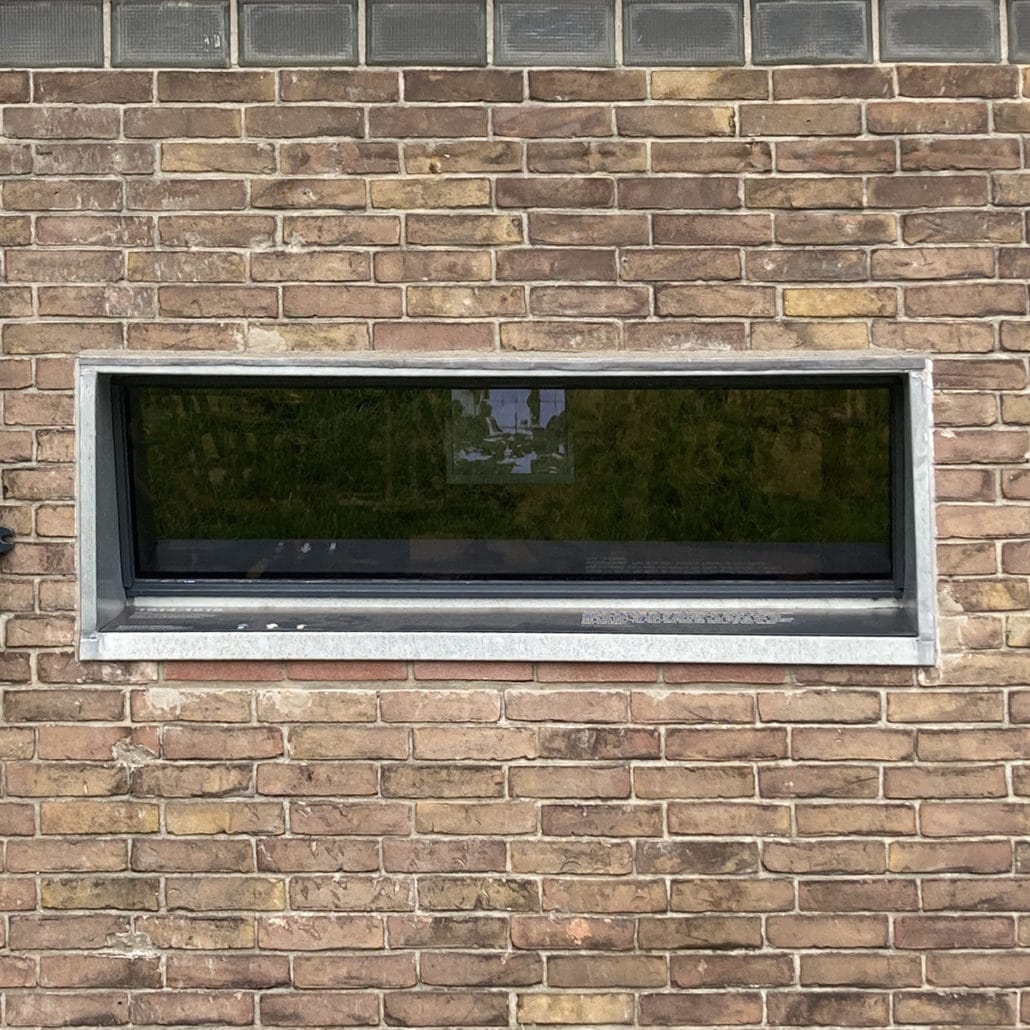
-5-
1914-1918 Overtime
During the First World War, the Dutch army orders large quantities of weapons and munitions. The factory is working overtime to meet the demand and supply troops at the border with weapons. As production increases, so too does the workforce. This is the factory’s heyday. The armistice in 1918 marks an end to its growth.
– Film clip on the Hembrug factory from Holland Neutraal: Leger en Vlootfilm (1917), a propaganda film about the Dutch army [Eye]
The Netherlands remains neutral during the First World War. The Ministry of War intends the film to drum up support for Dutch neutrality, while at the same time demonstrating the might of the Dutch troops.
Number of employees:
1914: approx. 1,500
1917: approx. 8,500
1919: approx. 5,200
Quote:
‘When I started at the factory in 1914, thousands of people were already working there. I worked on the revolver line, cutting wire, shaping and cutting out pipes, And the process was very different then. Nowadays, you press a button and it’s all automatic. Back then, we worked at machines powered by transmission belts. The noise was phenomenal; nobody could understand one another.’
Anonymous, employee of Artillerie Inrichtingen
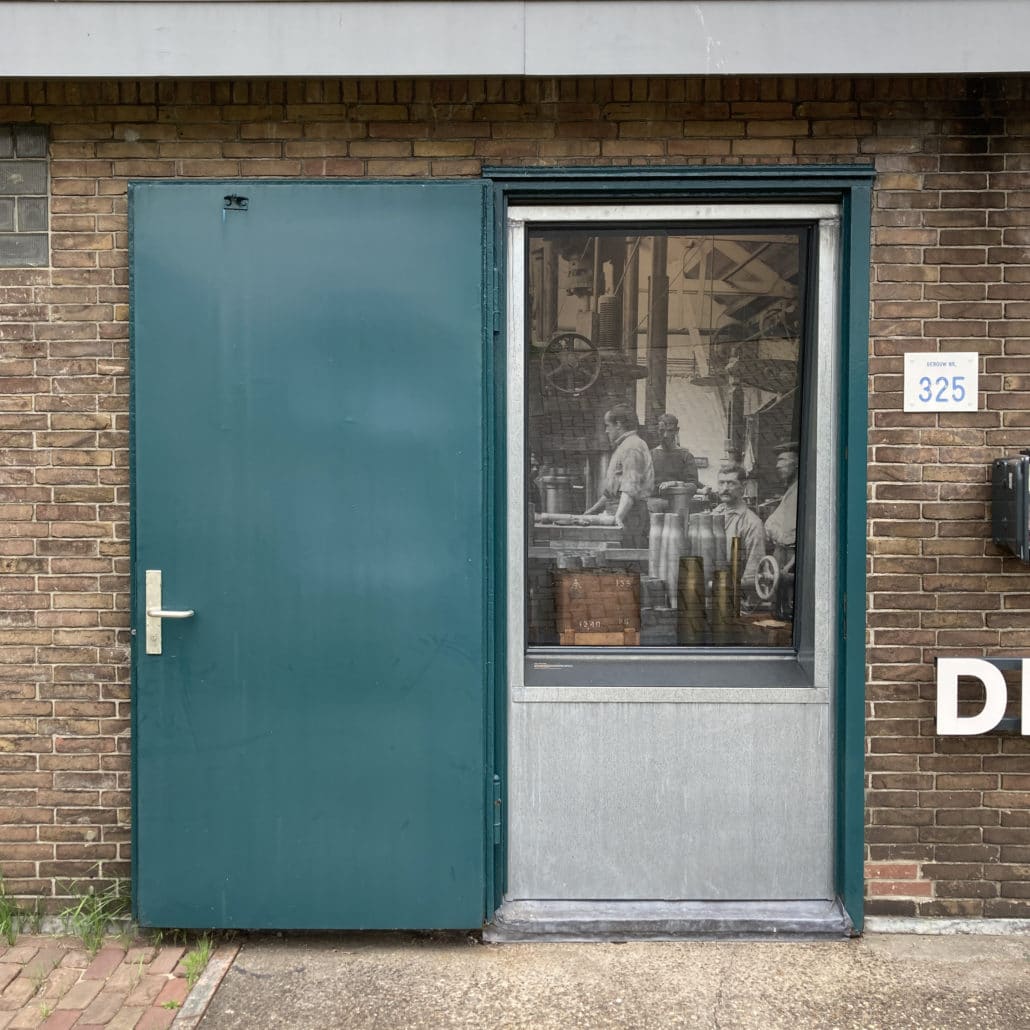
-6-
At work
A glimpse into the cartridge factory that makes large cartridges – building 112 on the Hembrug site, 1914 (Nationaal Militair Museum). A hydraulic press presses a rim onto cartridge cases.
In the foreground are ammunition boxes and cartridges.
-7-
-1- 1907 De Hembrug
The site and the new factory of Artillerie Inrichtingen soon start being referred to as Hembrug, after the nearby rail bridge over the North Sea Canal.
The new rail bridge is opened in 1907, replacing the old bridge built in 1876. The nearby station of Hembrug primarily serves the employees of the local factories. Very few trains stop here, except at peak times. In 1983, the bridge was demolished and replaced with the rail tunnel.
– Arrival of the train at the Hembrug stop
Number of employees: approx. 1000
– The new Hembrug, 1911 (Zaanstad Municipal Archives)
At the time of its completion, the new rail bridge is Europe’s biggest swing bridge, with a mobile section measuring almost 130 metres.
– Model of the mobile middle section of the new rail bridge.
Made by Jan van Zaanen, an employee in the development department, as a gift for employees retiring from the company.
-2- 1895 From Delft to Zaandam
The factory on the Hembrug site is built in 1895, to produce the new standard weapon for the Dutch army: the M95 rifle, better known as the Hembrug rifle. There was no space to produce this at the old factory in Delft. The new location in Zaandam was chosen because of its strategic position within the Defence Line of Amsterdam, and its good accessibility by water and rail.
The first buildings to be completed were the headquarters, the ammunitions factory, a workshop for portable weapons, and depots for storage. Many more structures were added over the ensuing years.
– The factory under construction, 1898
– The new headquarters of Staatsbedrijf der Artillerie Inrichtingen by the North Sea Canal, 1898 [Nationaal Militair Museum]
– Interior of the new ammunitions factory, 1898
-3- 1679 Founding
In the ‘rampjaar’ (disastrous year) of 1672, the Republic of the Netherlands comes under attack from England, France and the diocese of Münster and Keulen. The Dutch army is found sorely wanting. In response, the ‘Staatse affuitmakerij” (State gun carriage makers) is founded in Delft, in 1679. In the 19th century, the workshop for gun carriages, small arms, and cannons evolves into a fully-fledged ammunitions and arms factory. In 1887, its name is changed to Staatsbedrijf der Artillerie Inrichtingen.
– Deed of incorporation of the affuitmakerij in Delft, August 4, 1679
– The arms depot in Delft, ca. 1780 [TU Delft – bijzondere collecties]
– Construction workshop of Staatsbedrijf der Artillerie Inrichtingen in Delft, ca. 1900 [Nationaal Militair Museum]
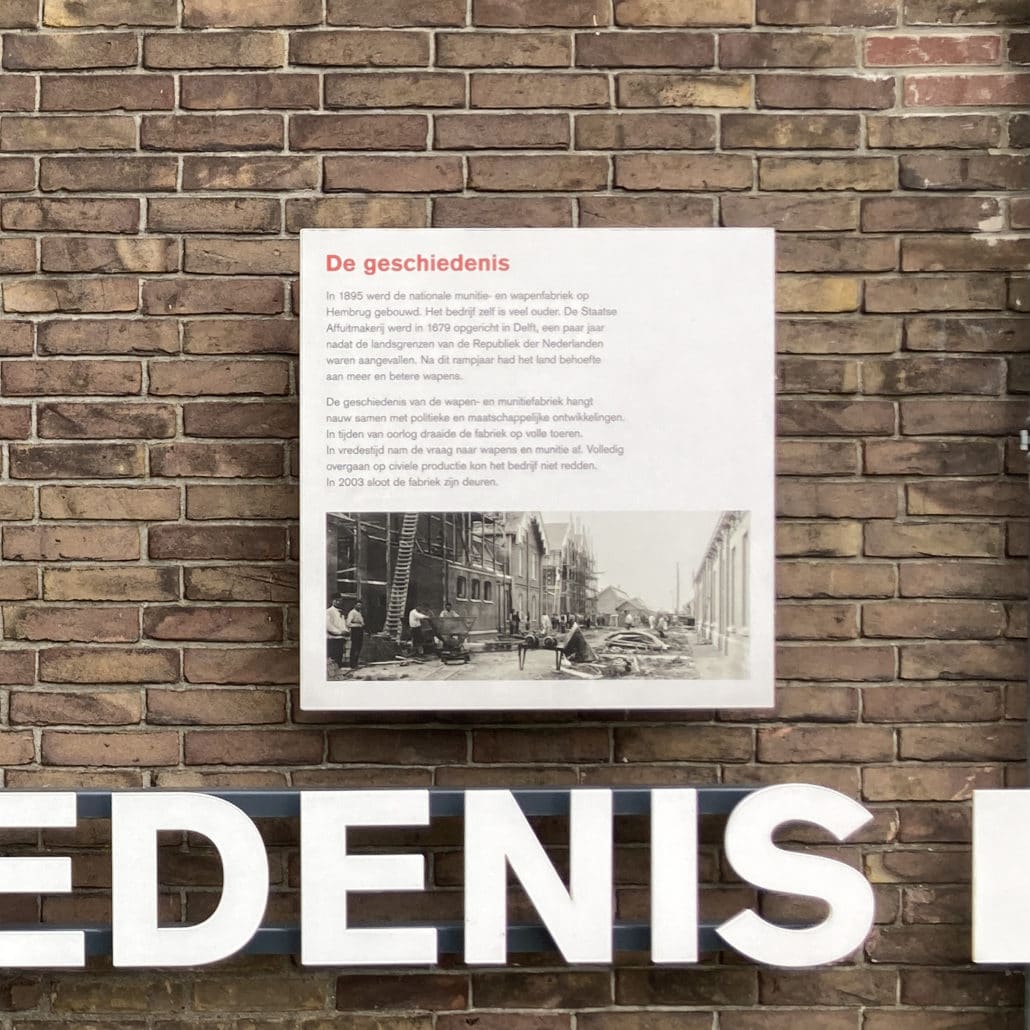
-8-
The history
The national ammunitions and arms factory is built at Hembrug in 1895. The company itself is much older. The Staatse Affuitmakerij is established in Delft in 1679, a few years after the assaults on the national borders of the Republic of the Netherlands. In the wake of this ‘rampjaar’, or Disaster Year, the country is in need of more and better weapons.
The history of the ammunitions and arms factory is inextricably linked with political and societal developments. In times of war, the factory operates at full capacity.
In peacetime, demand for arms and ammunitions declines. Switching entirely to civilian production is not enough to save the company. The factory closes down in 2003.









